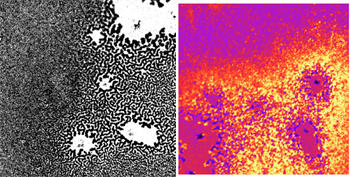
(Left) Polarization sensitive light microscopy shows the pattern of north poles (black) and south poles (white) on thin layer of magnetic cobalt. (Right) The researchers found that the pattern of north poles and south poles spontaneously fluctuates over time. Strongly fluctuating areas are encoded here as brighter colors. Researchers hope to use this data to make more sensitive magnetic materials whose domains can be flipped more energy efficiently, a boon to those with rapidly dying smartphone batteries. Images show an area approx. 75 micrometers across.
While the mysterious, unseen forces magnets project are now (mostly) well-understood, they can still occasionally surprise us. For instance, thin films of cobalt have been observed to spontaneously switch their poles—something that typically doesn't happen in the absence of an external magnetic field. Physicists at the National Institute of Standards and Technology (NIST) and the University of Maryland (UMD) have measured this phenomenon on the largest scale yet.
The paper appeared in Physical Review B.
Most magnets are "permanent," meaning a magnetic field of some strength must be applied to reverse their north and south poles. This permanence enables the billions of tiny magnets in hard drives to reliably store data. And smartphone compasses use nanomagnetic sensor technology to detect the Earth's magnetic field.
At the present time, creating and detecting these magnetic fields takes a good deal of energy. Making these devices more energy efficient will require more sensitive magnets that can be influenced by small magnetic or electric fields. However, as these magnets become more sensitive, they also become more unstable, flipping from north to south and back, even with no magnetic field.
The NIST/UMD team mapped out this instability in a film of cobalt, only a few atoms thick, and determined the conditions under which the instability arises.
They hypothesize that the development of magnetic technology will benefit from their continuously flipping cobalt films, which can function as extremely sensitive magnetic test beds. Many proposed devices implement layers of ferromagnetic material that must be individually controlled by electric fields to be useful.
According to NIST researcher Andy Balk, however, most magnetic materials are too stable to be influenced at all by electric fields, and researchers have no way of knowing if their proposed devices are even close to working.
"As an alternative," Balk says, "we could make a proposed magnetic device from our unstable film. This way, even if the film were influenced only a very small amount, we would see, for example, slightly more north flips than south flips, and we would know we are on the right track."
The current measurements were done with video-rate Kerr microscopy, a form of polarized light microscopy that can image the fine-grained details of a material's magnetic state. The scientists found that if undisturbed by outside influence, the magnetic fluctuations in the thin cobalt film interact with each other; a fluctuation from north to south will always have a corresponding nearby fluctuation from south to north.
Interestingly, these fluctuations exhibit scale invariance—meaning that their behavior is the same regardless of the length scale on which they are observed—a property they share with otherwise unrelated phenomena such as earthquakes and crumpling paper.
The researchers are continuing this work at NIST by developing these thin films into sensitive field detectors for computing and biomedical applications.
A.L. Balk, M.D. Stiles and J. Unguris. Critical behavior of zero-field magnetic fluctuations in perpendicularly magnetized thin films. Physical Review B. Published 4 November 2014.

